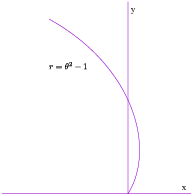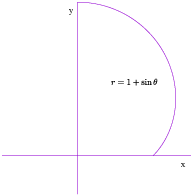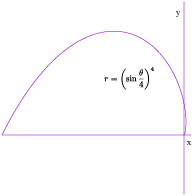If a curve is given in polar coordinates ![]() , an integral for the length of the curve
can be derived using the arc length formula for a parametric curve.
Regard
, an integral for the length of the curve
can be derived using the arc length formula for a parametric curve.
Regard ![]() as the parameter. The parametric arc length
formula becomes
as the parameter. The parametric arc length
formula becomes
![]()
Now ![]() and
and ![]() , so
, so
![]()
![]()
Square and add, using the fact that ![]() :
:

Hence,
![]()
Note: As with other arc length computations, it's pretty easy to come up with polar curves which lead to integrals with non-elementary antiderivatives. In that case, the best you might be able to do is to approximate the integral using a calculator or a computer.
Example. Find the length of the curve ![]() from
from ![]() to
to ![]() .
.

![]()
![]()
![]()
The length is
![]()
Example. Find the length of the cardiod ![]() for
for ![]() to
to ![]() .
.

![]()
![]()
![]()
I'll do the antiderivative separately:
![]()
![]()
![]()
![]()
The length is
![]()
Example. Find the length of the polar curve
![]() for
for
![]() to
to ![]() .
.

![]()
![]()
![]()
The length is
![]()
I'll do the antiderivative separately:
![]()
![$$\left[u = \cos \dfrac{\theta}{4}, \quad du = -\dfrac{1}{4} \sin \dfrac{\theta}{4}\,d\theta, \quad d\theta = -4 \dfrac{du}{\sin \dfrac{\theta}{4}}\right]$$](arc-length-in-polar40.png)

So
![$$\int_0^\pi \left(\sin \dfrac{\theta}{4}\right)^3\,d\theta = \left[-4 \cos \dfrac{\theta}{4} + \dfrac{4}{3} \left(\cos \dfrac{\theta}{4}\right)^3\right]_0^\pi = \dfrac{8}{3} - \dfrac{5 \sqrt{2}}{3} = 0.30964 \ldots.\quad\halmos$$](arc-length-in-polar42.png)
Copyright 2020 by Bruce Ikenaga